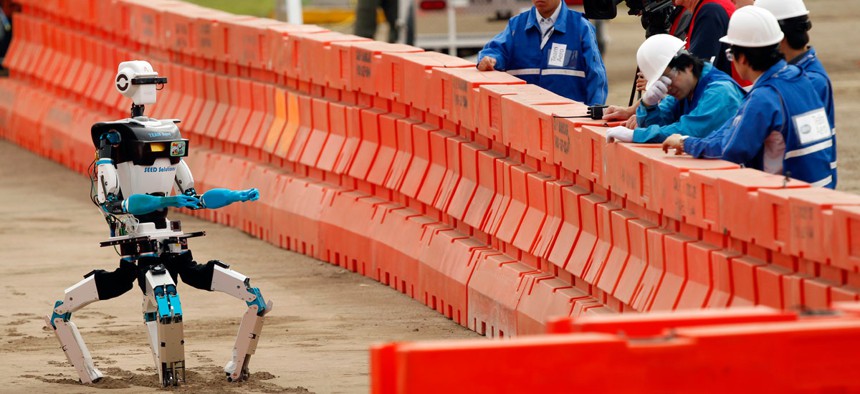DARPA Wraps Up Robotics Challenge But Don’t Expect C-3PO Any Time Soon

University of Tokyo robot Aero DRC competes in he first stage of the U.S. Defense Advanced Research Projects Agency Robotics Challenge in Pomona, Calif. Alex Gallardo/AP
The Pentagon's research agency was looking for robots that could eventually help in humanitarian crises.
The Defense Advanced Research Projects Agency wrapped up last week a two-year tech challenge in search of robots that could one day be deployed in disasters too dangerous for human emergency response teams.
But it could be years before the winning technology is actually deployed during a disaster.
DARPA, the Pentagon's emerging technology group, hosted the robotics challenge finals last weekend in Pomona, California. Teams from all over the world, including the United States, Italy, Germany, South Korea and Japan, designed robots to complete basic tasks that might be useful in a crisis: walking up stairs, driving alone, turning valves and navigating through rubble, among others.
Participant robots completed similar tasks on the competition course, in conditions designed to simulate a disaster scene. (The course in each phase of the challenge was progressively more difficult. In the final phase, teams were not allowed to belay their robots, preventing a fall, and robots were required to be battery powered, to show they could operate in the absence of a continuous power source.)
DARPA launched the first phase of the challenge in 2013 in response to the 2011 nuclear disaster at Fukushima, Japan. During that disaster, robots proved largely ineffective at tasks such as manipulating buttons or activating pressure valves, DARPA spokesman Jared Adams told Nextgov.
A team from South Korea, with its robot DRC-Hubo, took the top spot and $2 million in prize money. Teams from Florida and Pittsburgh won $1 million and $500,000, respectively.
Still, humanitarian groups are "probably several years away from these types of robots being deployed in a disaster zone," Adams said. "Right now, we feel like we've shown the art of the possible."
DARPA is still figuring out if and how to maintain working relationships with the competitors, many of whom plan to reinvest their prize money into refining their robots, Adams said.
NEXT STORY: The Internet in Space? Slow as Dial-Up


